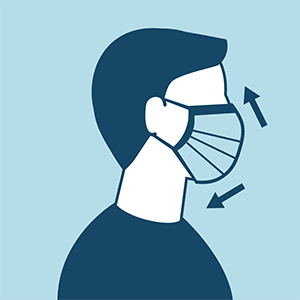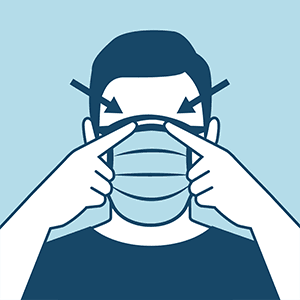CDC: Use of Cloth Face Coverings to Help Slow the Spread of COVID-19
How to Wear a Cloth Face Covering

Cloth face coverings should—
- fit snugly but comfortably against the side of the face
- be secured with ties or ear loops
- include multiple layers of fabric
- allow for breathing without restriction
- be able to be laundered and machine dried without damage or change to shape
CDC on Homemade Cloth Face Coverings
CDC recommends wearing cloth face coverings in public settings where other social distancing measures are difficult to maintain (e.g., grocery stores and pharmacies), especially in areas of significant community-based transmission.
CDC also advises the use of simple cloth face coverings to slow the spread of the virus and help people who may have the virus and do not know it from transmitting it to others. Cloth face coverings fashioned from household items or made at home from common materials at low cost can be used as an additional, voluntary public health measure.
Cloth face coverings should not be placed on young children under age 2, anyone who has trouble breathing, or is unconscious, incapacitated or otherwise unable to remove the mask without assistance.
The cloth face coverings recommended are not surgical masks or N-95 respirators. Those are critical supplies that must continue to be reserved for healthcare workers and other medical first responders, as recommended by current CDC guidance.

Should cloth face coverings be washed or otherwise cleaned regularly? How regularly?
Yes. They should be routinely washed depending on the frequency of use.
How does one safely sterilize/clean a cloth face covering?
A washing machine should suffice in properly washing a face covering.
How does one safely remove a used cloth face covering?
Individuals should be careful not to touch their eyes, nose, and mouth when removing their face covering and wash hands immediately after removing.
Related Articles
Cigna - Coronavirus (COVID-19) Resource Center
Cigna is committed to improving your health, well-being, and peace of mind. Contact your Primary Care Provider (PCP) If you think you have been exposed to COVID-19 or develop symptoms such as a fever, cough, or have difficulty breathing, call your ...Humana Expands Access to Telehealth Services to Help Reduce Coronavirus Risk
Member cost sharing waived for telehealth visits to participating providers Audio-only telephone as well as video visits covered Participating providers reimbursed at full office-visit rates Tuesday, March 24, 2020 4:15 pm EDT PDFRSS "We hope these ...Coronavirus Myths
19 Coronavirus Myths You Should Stop Believing Myth: Coronavirus is the most dangerous and deadly virus This is false. More than 80 percent of people who are infected with coronavirus will recover, stresses Len Horovitz, MD, a pulmonary specialist at ...Mental Health and Coping During COVID-19 | CDC
Outbreaks can be stressful The outbreak of coronavirus disease 2019 (COVID-19) may be stressful for people. Fear and anxiety about a disease can be overwhelming and cause strong emotions in adults and children. Coping with stress will make you, the ...Federal health care legislation and regulations
CARES Act, COVID-19 Relief Package, Signed into Law Strengthens Federal Government and Health Care System’s Response On March 27, 2020, President Trump signed the Coronavirus Aid, Relief and Economic Security (CARES) Act into law. The $2 trillion ...